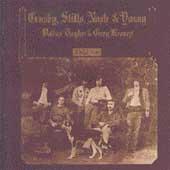Classic's CSN&Y Déja Vu: Tell Me Something I Don't Already Know!
Four producers, four colossal egos, and four radically different mindsets combined to produce an artistically schizophrenic, creative mess of an album. The addition of Young, brought a much needed electric shock to the folk group setting of the original CSN album, but for those of us old enough to remember Stills and Young in the far more daring and compelling Buffalo Springfield, CSN was predictable, pretentious and packaged and adding Young for the second round didn’t change things all that much.
Before hearing the CSN LP when it first came out back in 1969 I was struck by the harsh dissonance of the album cover and the inner gatefold. Outside? Laid-back country hippies sitting on a beat up couch. Inside? Smug, self-satisfied-looking fur-coated post-hippies dramatically posed and lit in a shot that literally invented “Big Chill” yuppie-dom right then and there. You couldn’t see the million dollar Vail ski chateaus in the shot, but you could almost feel them. Not that there’s anything wrong with that—they earned it—but the inside jacket had the effect of exposing and amplifying the pathetic poseur phoniness of the outer one. Yet there was plenty of good music in the debut album’s grooves and the blending of the voices was magical.
This follow-up is not nearly as successful in my opinion, though that runs contrary to popular opinion. Shall we start with the silly cover photo? Perhaps having blown their hippie authenticity on the first album cover, they felt it necessary to go for a full-blown Halloween costume party? Then you open the turn of the century jacket and find early computer-style typeface inside? Perhaps it’s meant to express the musical schizophrenia found in the grooves.
Stills opens the album exhorting the “Woodstock Nation,” to “Carry On,” because “…love is coming to us all.” From where he doesn’t say, and despite the tuneful boldness of the music, the message is confused. “Teach Your Children,” Graham Nash’s precious and presumptuous suburban parenting lesson was tough to take in 1970 and no easier to swallow today, but next to Crosby’s silly trifle “Almost Cut My Hair,” it was genius. Young’s childhood reminiscence “Helpless,” has a lazy charm that stands up well, but Gram Parsons’s “Hickory Wind” mines the same territory with devastating results. With each member having had a say, the group ends the side in neutral territory with a muscular but already dated and unconvincing commercial take on Joni Mitchell’s “Woodstock.” Does that add up to an album side of greatness?
Side two is a big improvement, though Nash’s embarrassingly dainty drawing room ditty “Our House,” is no less enraging today than it was back in 1970, and I could swear I imagined its use back then in some future television commercial. Crosby’s oddly metered title tune holds interest, though it sounds like a reject or a bonus tune from a Jefferson Airplane album. “4+20,” “Country Girl,” and “Everybody I Love You” end the set in the plus column but instead of adding up to an “album” by a “group” at a time when such achievements were common-place, Déja-Vu sounds like what it was: four big talents (and big egos) in a post-group (Buffalo Springfield, Hollies, Byrds) setting where none of the participants is willing to submerge his song-writing ego for the benefit of the group—kind of like The Beatles’s “White Album.”
But don’t let my whining stop you! If you like this album, Classic’s reissue has much to like. The care, time and expense taken to re-create the cover art is impressive. It’s remarkable how close the reissue comes. The only differences are that the gold leaf doesn’t shimmer quite as brightly, and the leather texture is lost under the gold leaf on the reissue.
As for the sound, I compared the reissue with three pressings: two 1841 Broadway American Atlantic originals and an original plum/red label UK original. First of all, the two originals don’t sound at all alike, and upon close inspection, one has a “deep groove” like ring in the label and one doesn’t though inner groove markings appear to be the same. You can bet that many lacquers were cut from various tapes on numerous lathes, and various pressing plants were called upon to produce this popular record, so anyone purporting to know what the “original” LP sounds like is probably talking through his or her hat. One of my “originals” has tape hiss that sounds like it was generated from a copy of the master tape, and one sounds much quieter, indicating it may have been a truly original pressing but I don’t know.
Look, this was never a great sounding record. It’s just alright, with a hard left/right/center spread and plenty of distortion built-in—especially when the bass enters on the right channel after the opening guitar riff. Classic’s clarity tells you some things about the recording you probably don’t want to know, but that’s like what happens when you see your favorite hot actress’s complexion on an HDTV for the first time. It’s not the fault of the television!
That said, the reissue is somewhat drier in the midrange and more “literal” on top—something common to most Bernie Grundman cuts, even though he’s using a tube driven cutting system—and it works better on some records than on others. It works great here in terms of ferreting out individual vocal parts and overall, this is a very successful reissue, generated, Classic says, from the original master tape, pried away after much cajoling from the holder, who I bet is one of the band members.
The 200g flat RTI pressing was silent and free of defects, so if this album is one of your favorites, and you can’t find a clean “original original,” (and there’s no guarantee you will even if it says “1841 Broadway”) your money will be well spent.
- Log in or register to post comments


